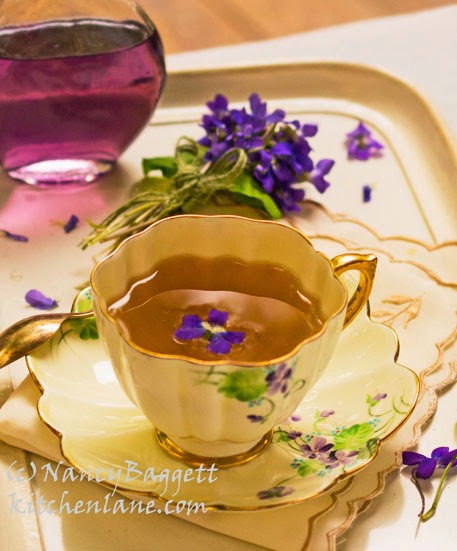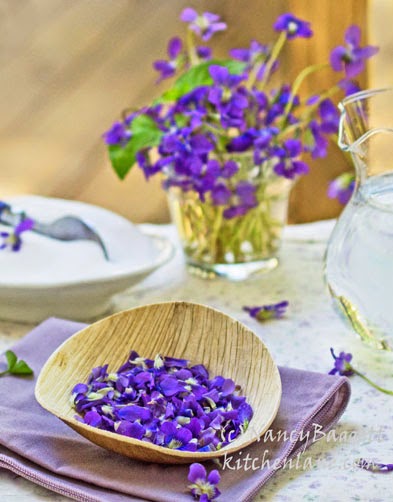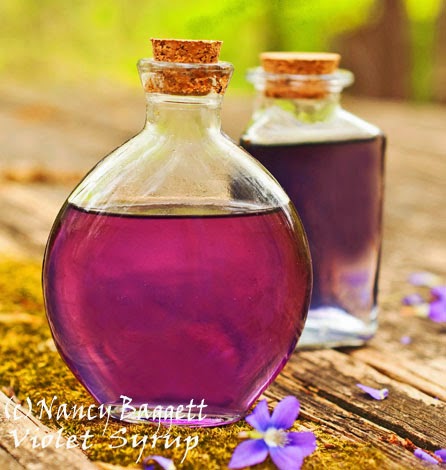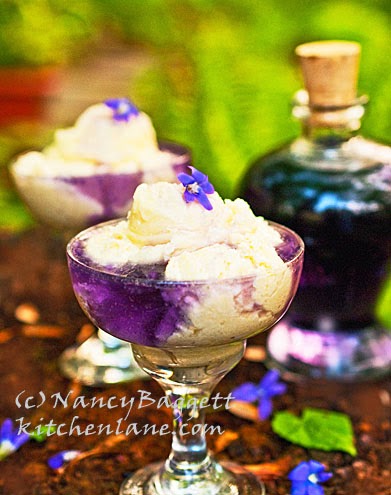Each spring I take a page from traditionalist European and some American cooks and herbalists and harvest native woodland violets for culinary use. The ones featured here are the “plain” blue violet, viola sororia, which appears in abundance in woods and meadows all across the eastern U. S. When I have enough–and as you can see below I certainly do this year!–I make a batch of violet syrup. As the photo above shows, violet syrup ingredients are very basic–violet petals, sugar, and water.
If you don’t have an abundance of woodland violets, you can still take advantage of what you have. I use the flowers as garnishes for desserts and fruit dishes, and to brighten salads and vinaigrettes. A quick YouTube video showing me out harvesting and using violets in the kitchen is here.
 |
| Common Blue Violet, Viola sororia |
The practice of cooking with violets is not too common in the U.S., but is well known in France and other central European countries. An Internet search on “sirop de violettes” turns up literally dozens of recipes for home cooks on French sites. In their recipes Europeans usually employ a slightly darker purple scented and more flavorful native violet called viola oderata.
This variety has been imported into the U. S. and has naturalized readily, so it can sometimes be found “growing wild” in American woodlands. I’ve never come upon a patch of scented violets locally, but have been growing two purchased varieties, one called Clive Groves, the other called Reid’s Crimson in my yard for several years with great success. (Yes, the Reid’s Crimson is a glorious crimson color.)
 |
| Chamomile tea sweetened with violet syrup |
In past centuries violet syrups and tinctures were widely used as medicinals and tonics. The blooms are in fact rich in antioxidants and a source of vitamins A and C, so were beneficial in preventing vitamin deficiencies. In medieval times pharmacists and healers provided assorted violet concoctions to help insomnia, soothe sore throats, and ease headaches. Even further back, Macer’s Herbal (first written in Latin in the 10th century) mentions the violet as one of the herbs considered powerful against ‘wykked sperytis.’
Frankly, I don’t worry about warding off either evil spirits or headaches with my violet syrup, but I do find a little splash of it a pleasant way to sweeten a cup of chamomile tea or a dish of seasonal berries. Along with a few fresh violet blooms for garnishes, the syrup likewise makes a pleasing topper for a plain or berry ice cream sundae. The syrup is mild and just faintly floral; it’s color is what lends the large share of its appeal.
- 2¼ to 2½ cups loosely packed fresh purple violet blooms, all stems removed before measuring
- 4 to 5 strips (1-inch by ½-inch) lemon zest (no white pith)
- ¾ cup boiling water
- ¾ cup granulated sugar
- Gently but thoroughly wash the violets in a colander under barely warm water. Shake, then let stand to drain thoroughly. Put the violets in a 4-cup measure or similar-sized heat-proof non-reactive bowl. Pour the boiling water over them. Stir them down into the water, then cover and let stand for at least 1½ hours and up to several hours, if preferred.
- Pour the violet-infused water mixture through a fine sieve into a non-reactive 1- to 2-quart saucepan (preferably one with a lip for pouring; discard the sieved violets and lemon strips. Stir the sugar into the violet water. Bring to a boil, stirring, over medium heat. Adjust the heat so the mixture boils gently. Cook without stirring for 4 minutes. Check the syrup color, and if you desire a warmer purple shade stir in 2 or 3 drops of fresh lemon juice; for a brighter magenta shade, a drop at a time, thoroughly stir in more lemon juice until the desired shade is obtained. Bring the mixture back to a boil and cook 1 minute longer.
- Let cool slightly. Then pour the syrup into a clean sterilized bottle or jar. Cool to room temperature, then store, refrigerated, for up to 2 months. Makes about 1 cup.For how to use violets in salads and vinaigrette dressings, go here. To turn them into an all-natural purple decorating sugar, go here. For how to use them fresh and candied as pastry decorations follow the links below.







Thanks for posting about this–interesting! I’m guessing that the purple color, which comes from a plant pigment called anthocyanin, is too fragile to take that amount of heat. As I say in the post, this pigment also changes color and become more pinkish or reddish in the presence of acid. (This is also why red cabbage turns redder when cooked with vinegar.) And the bright color of the syrup will fade some if it’s exposed to sun and heat.
I made violet simple syrup with V sororia yesterday, but did not follow this recipe — just did what i have done to make simple syrups from other fruits. That is, i boiled the violets in with the sugar and water. My result was a near emerald syrup. Intriguing that the purple color will come out of the petals in just warm water, but a higher temperature & with sugar pulls the green out of the sepals.
I have only seen recipes that call for fresh violets. I’m guessing that because the color and scent fade as the flowers dry, a dried violet syrup wouldn’t be appealing. It would probably be fine to make an infusion of only a small number of blooms everyday, then freeze the liquid until you have enough to put them together into a larger batch. Or perhaps the blooms could be frozen and then processed all at once–but I haven’t tried this.
Can you pick and dry them till you have enough or do they have to be fresh
I guess she thought that people would have already picked them if they wanted them. Most people don't seem that interested; some consider them weeds…
I love violets. My mom used to take me to gather them when I was a kid. I think back about that now and remember that we took them from peoples' yards. Wonder why she did that???
I have lots in my yard now, but not as many as you do.
They are all over the place in my neighborhood and yard. I love using them.
OMG! These are gorgeous. We have violets growing wild in our yard.